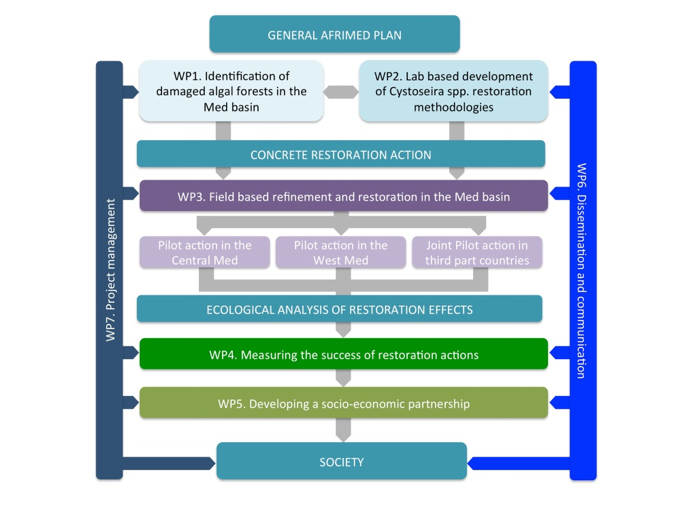PROJECT OVERVIEW
AFRIMED IS AN EUROPEAN PROJECT ON THE RESTORATION OF THE DEGRADED MACROALGAL FOREST (Cystoseira)
This project has received funding from the Executive Agency for Small and Medium Enterprise (EASME) and European Maritime and Fisheries fund (EMFF) under grant agreement No 789059
About the project:
- Project budget (in €): 1.486.683
- Partners: 11
- Countries: 8
- Starts: January 16, 2019
- Duration (in months): 36
As the deployment of blue economy sectors across Europe accelerates, it is vital that the resilience of marine and coastal ecosystems is maintained and restored in order to allow economic growth to be achieved in a sustainable manner. However, despite best efforts to conserve and sustainably manage marine ecosystems, attempts to mitigate human threats are generally proving inadequate to halt biodiversity loss and habitat degradation. Consequently, there is a need for the European Union to turn policy objectives relating to secure, safe, clean and sustainably managed oceans into actions and impacts. This is particularly true in coastal habitats, where the effects of multiple stressors are causing widespread loss of critical coastal habitats, a pattern which is projected to increase with climatic change.
Macroalgal forest ecosystems play a key role in enhancing coastal primary productivity, supporting complex food webs and are integral to the delivery of a multitude of goods and services. However, the massive losses of macroalgal forests that are occurring all over the Mediterranean basin are going largely unnoticed and we do not have the tools or knowledge required to bring about change. AFRIMED seeks to bring about a step-change in this situation, by developing, implementing and promoting a protocol to effectively restore macroalgal forests (Cystoseira spp.) in the Mediterranean Sea in order to maximise the delivery of conservation, societal and economic benefits
In order to achieve this objective, we will harness the knowledge and expertise of a multidisciplinary team to develop, refine and implement novel restoration actions, and formulate guidelines that can be used to bring about measurable change in macroalgal forest health in the region. A key ambition is to deliver clear and robust methods that can support the successful upscaling of the project in larger and new regions and maximise buy-in from, and the benefits provided to, relevant stakeholders.
This objective will be achieved by
- Bringing together the information required to spatially prioritise restoration efforts under present-day and future conditions;
- undertaking novel laboratory and field-based experiments in order to maximise the probability of restoration success and the delivery of ecosystem services
- delivering concrete and robust methods that can be used to replicate and upscale the restoration efforts;
- promoting cooperation with the private sector and public authorities, enhancing mutual scientific learning across the region and raising the awareness of restoration in order to strengthen skills and buy-in across the Mediterranean;
- highlighting the ecosystems service and socio-economic benefits of restoration to a multitude of stakeholders;
- identifying the governance frameworks needed to optimise the delivery and effectiveness of restoration and the benefits provided to society.
AFRIMED aims we seek to improve existing and develop new innovative restoration actions in order to restore damaged or degraded macroalgal forests (Cystoseira) to the benefit the people and industries that utilise them and provide a framework from which to up-scale the approach.
Specifically, the project will:
- Identifying optimal locations to undertake restorative action, now and into the future, by bringing together existing knowledge of the status and distribution of macroalgal forests and the environmental and anthropogenic context of the regions in which they are found (WP1);
- undertaking novel laboratory experiments in order to optimise restoration techniques in a range of environmental and anthropogenic contexts commonly found in the region (WP2);
- exploring the response of Cystoseira species to future climatic conditions and modelling future distribution patterns in order to ensure restoration actions are relevant into the future (WP2);
- developing indicators, targets and monitoring frameworks to evaluate restoration success and quantify subsequent changes following restoration (WP2);
- passing from the lab to the field to refine restoration methods in “real-world” conditions (WP3);
- identifying methods and contextual factors that improve the efficiency and success rate of restoration and the delivery of goods and services (WP4);
- determining where the knowledge and lessons generated from the project can be applied to address policy needs and aspirations (WP4);
- engaging with local stakeholders to promote and facilitate replicability and transferability of know-how and generate support from local groups and industries (WP5);
- disseminating actions and results to increase the awareness of these important habitats and the benefits that can be obtained from restoring them (WP5).
